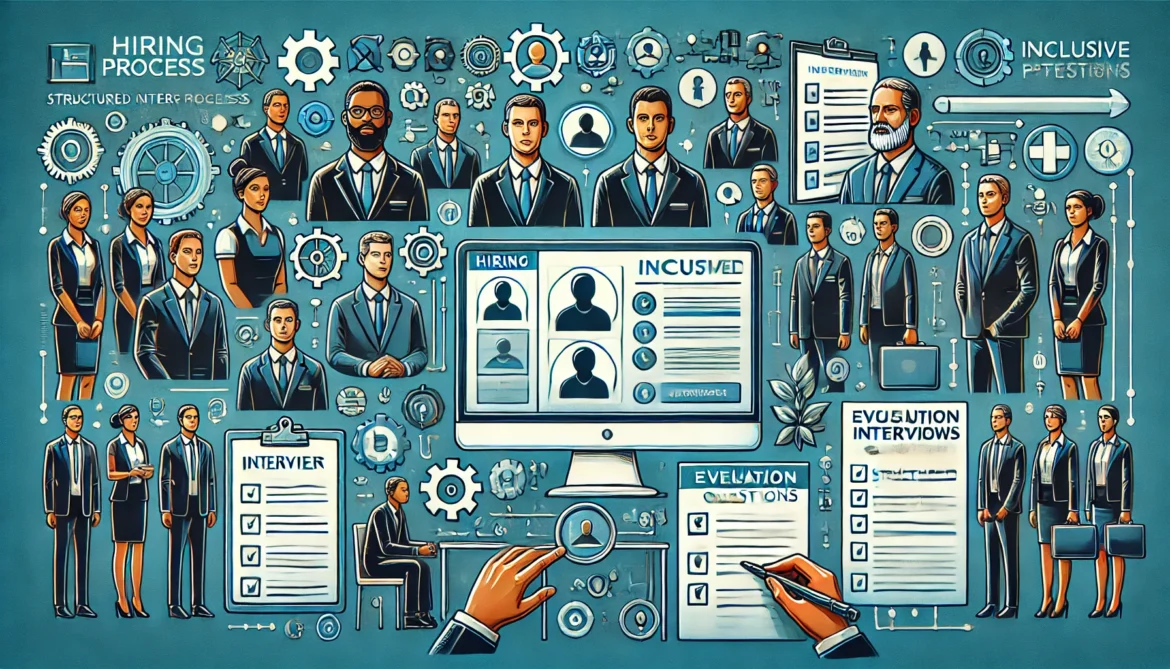Table of Contents
Key Takeaways
- Structured hiring processes lead to more consistent and fair hiring decisions.
- Inclusive hiring practices foster a diverse and dynamic workplace.
- Implementing a systematic hiring framework can help eliminate bias.
- Using data and research-backed methods increases the effectiveness of hiring.
Why Structured Hiring Processes Matter
Implementing a structured hiring process ensures consistency and fairness in hiring decisions. A well-designed process helps organizations build a more capable and diverse workforce while actively minimizing biases that can otherwise creep into an informal hiring method. Studies consistently indicate that organizations embracing structured hiring procedures see a 31% higher success rate in finding the right candidates.
This approach starts with learning how to hire the right person, which is crucial for any company’s long-term success. For those seeking detailed guidance on setting up a structured and inclusive hiring process, check out this insightful resource on how to hire.
The Benefits of Inclusive Hiring
An inclusive hiring process meets ethical and legal standards and enriches the workplace with diverse perspectives, experiences, and ideas. Companies that adopt inclusive practices often report significantly higher employee satisfaction and retention rates.
According to a recent survey by BBC, diversity in the workplace dramatically boosts problem-solving abilities and innovation. By valuing and integrating a range of experiences and viewpoints, companies can better navigate complex challenges, develop more creative solutions, and drive sustained growth. This results in a more dynamic, versatile, and effective organization overall.
Steps to Develop a Structured Hiring Process
- Define Job Requirements: Start by clearly outlining the skills, experience, and qualifications necessary for the role. This foundational step helps filter out unqualified candidates early in the process, ensuring that only the most suitable applicants move forward. Moreover, clearly defined job requirements set expectations for candidates and help in shaping the subsequent stages of the hiring process.
- Create A Standardized Interview Guide: Develop a set of consistent interview questions that will be asked to all candidates. This not only ensures fairness but also allows for direct comparisons between applicants, making it easier to evaluate their suitability for the role. Standardized interview guides can include a mix of behavioral, situational, and technical questions tailored to the job requirements.
- Use Scorecards: Implement evaluation scorecards to objectively assess candidate responses. This reduces subjectivity and helps maintain a standardized review process across interviewers. Scorecards typically include criteria such as communication skills, technical proficiency, cultural fit, and problem-solving abilities. By quantifying candidates’ responses, scorecards facilitate more transparent and data-driven decision-making.
- Involve Multiple Interviewers: Gather a diverse panel to minimize individual biases and provide a well-rounded candidate evaluation. Different perspectives can offer valuable insights that a single interviewer might overlook. Involving multiple interviewers also helps ensure that the candidate is evaluated on various aspects, such as team collaboration, leadership potential, and technical skills.
- Offer Training: Provide interviewers with training on effective and unbiased interviewing techniques. Asking open-ended questions, fostering an inclusive workplace, and identifying unconscious bias are a few of the subjects that can be covered in training sessions. Well-trained interviewers are better equipped to assess candidates fairly and contribute to a more equitable hiring process.
Promoting Diversity Through Inclusive Practices
Integrating diversity should be a core value in your hiring strategy. Steps like anonymizing resumes, using diverse hiring panels, and promoting a culture of inclusivity can help achieve this. For instance, anonymizing resumes by removing names, photos, and other identifiers can prevent unconscious bias during the initial screening.
Additionally, involving a diverse range of employees in the hiring process ensures that various viewpoints are considered. Organizations that prioritize diversity tend to perform better and are seen as more attractive by job seekers. Furthermore, implementing inclusive hiring practices aligns with broader social responsibilities and elevates the company’s reputation in the marketplace. Over time, a commitment to diversity can lead to a more innovative, adaptable, and resilient organization.
Leveraging Technology for Hiring Efficiency
Utilizing Applicant Tracking Systems (ATS) and other HR technologies can significantly streamline the hiring process. By automating processes like interview scheduling, resume screening, and applicant data storage, these solutions improve process efficiency and reduce the possibility of human error.
ATS software can also provide valuable data and analytics, allowing HR teams to track metrics such as time-to-hire, candidate source effectiveness, and diversity statistics. Moreover, by reducing manual tasks, HR professionals can focus more on strategic activities like candidate engagement and improving the overall candidate experience. Leveraging technology accelerates the hiring process and enhances its accuracy and effectiveness.
Continuous Improvement: Reviewing and Refining the Process
The hiring process should be dynamic and continuously evolve based on feedback and results. Regularly reviewing the effectiveness of your hiring methods and making necessary adjustments ensures that your approach remains fair, inclusive, and effective.
Gathering feedback from both successful candidates and those who were not selected can provide valuable insights into the strengths and weaknesses of your hiring process. Additionally, tracking key performance indicators (KPIs) such as quality of hire, time-to-fill, and candidate satisfaction can help identify areas for improvement.
By committing to continuous improvement, organizations can adapt to changing market conditions, stay competitive, and ensure long-term success in attracting and retaining top talent.
Conclusion: Commitment to Fair and Effective Hiring
It’s not only about filling jobs when you establish an organized and inclusive hiring process; it’s also about laying a solid basis for the future of your company. Through the allocation of time and resources towards the development and upkeep of these procedures, organizations may guarantee the recruitment of top personnel while cultivating a dynamic and diverse work environment.
The long-term benefits of such an approach are manifold, from improved team performance and increased innovation to enhanced company reputation and employee satisfaction. Ultimately, a commitment to fair and effective hiring processes lays the groundwork for a more successful, resilient, and inclusive organization.









